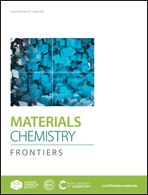Simultaneous one-step regulation of planarization and donor rotation to enhance multi-modal imaging guided therapy†
Abstract
The strategy of planarization and donor rotation has been widely applied to the design of theranostic agents due to the elevated intramolecular charge transfer (ICT) and non-radiative transitions. Herein, a series of D-π-A systems (TPA-OS, TPA-T-OS, and TPA-2T-OS) were prepared with triphenylamine (TPA) and onium salt (OS) as the electron donor and acceptor, respectively. Meanwhile, thienyl as a π-bridge was introduced to the molecule for simultaneously optimizing planarization and donor rotation. Single crystal structures showed that the dihedral angle of the three phenyl rings connected by the N atom in TPA was gradually increased, leading to the enhancement of non-radiative transitions for photoacoustic and photothermal properties. At the same time, the ICT effect was enhanced by planarization, which was conducive to Type I ROS generation and NIR fluorescence emission (833 nm). Particularly, TPA-2T-OS was particularly suitable for multi-modal imaging-guided therapy (photodynamic and photothermal therapy) in vivo. The one-step regulation provided a convenient and effective method for the design of theranostic agents for simultaneously improving the imaging and therapy performance.

- This article is part of the themed collection: FOCUS: Recent progress on bioimaging technologies


 Please wait while we load your content...
Please wait while we load your content...